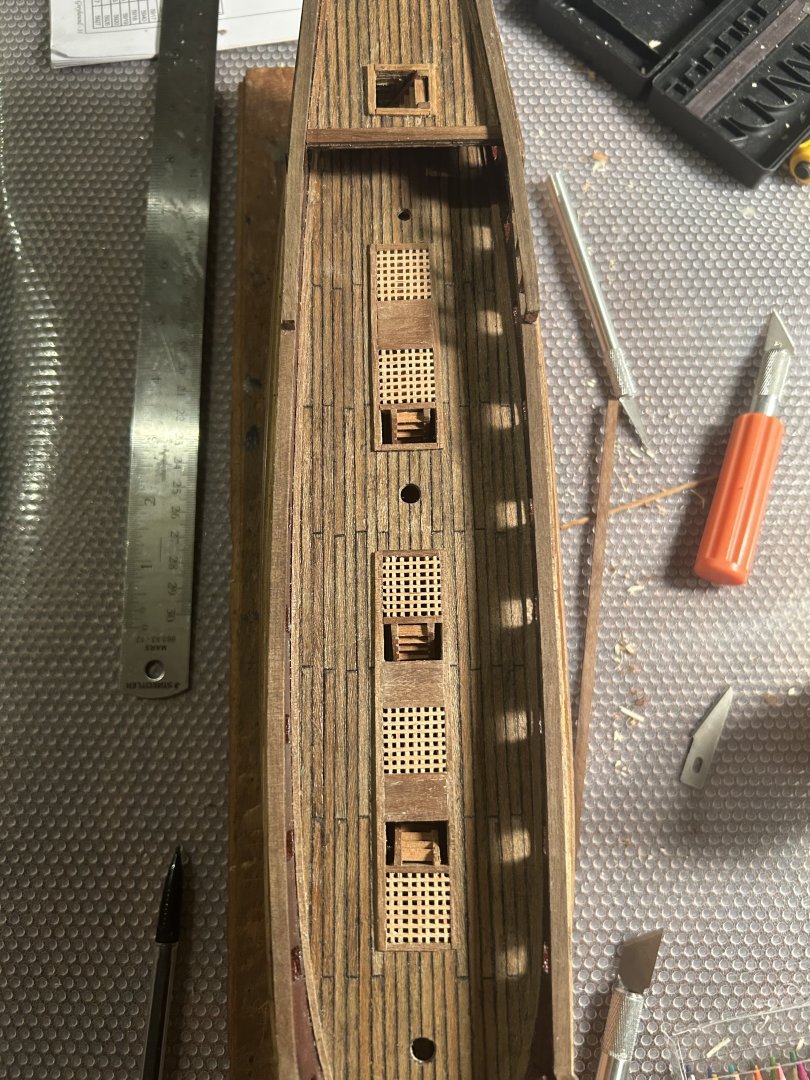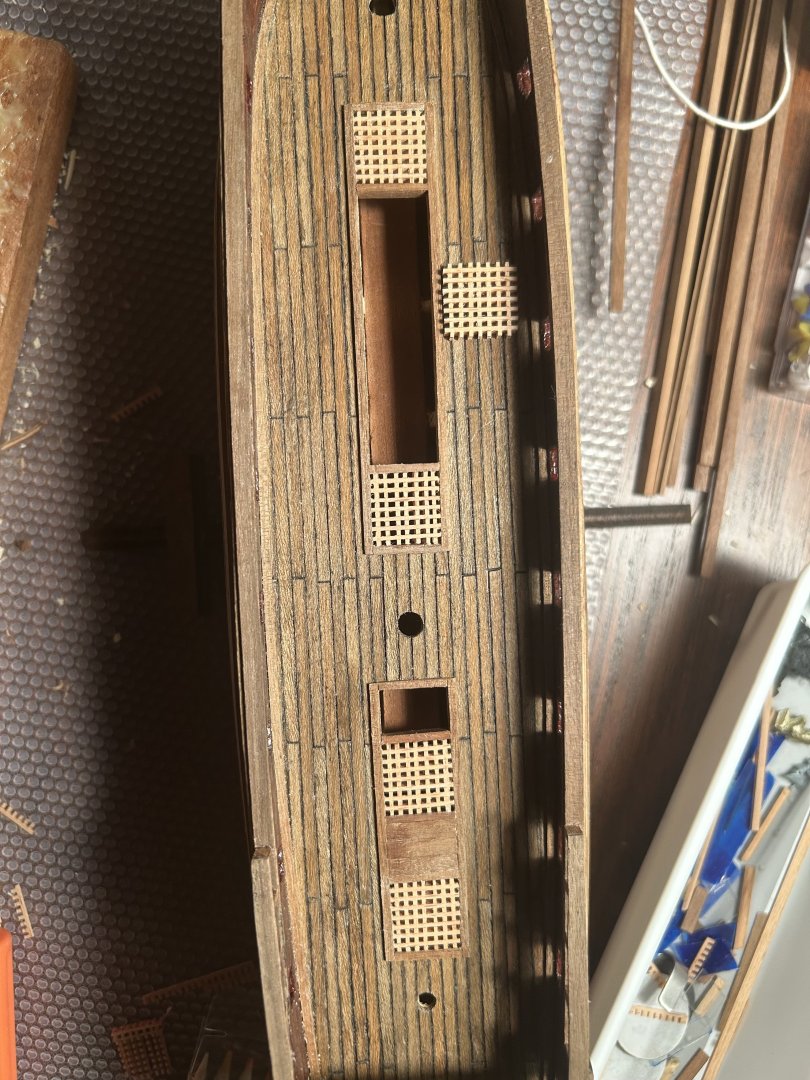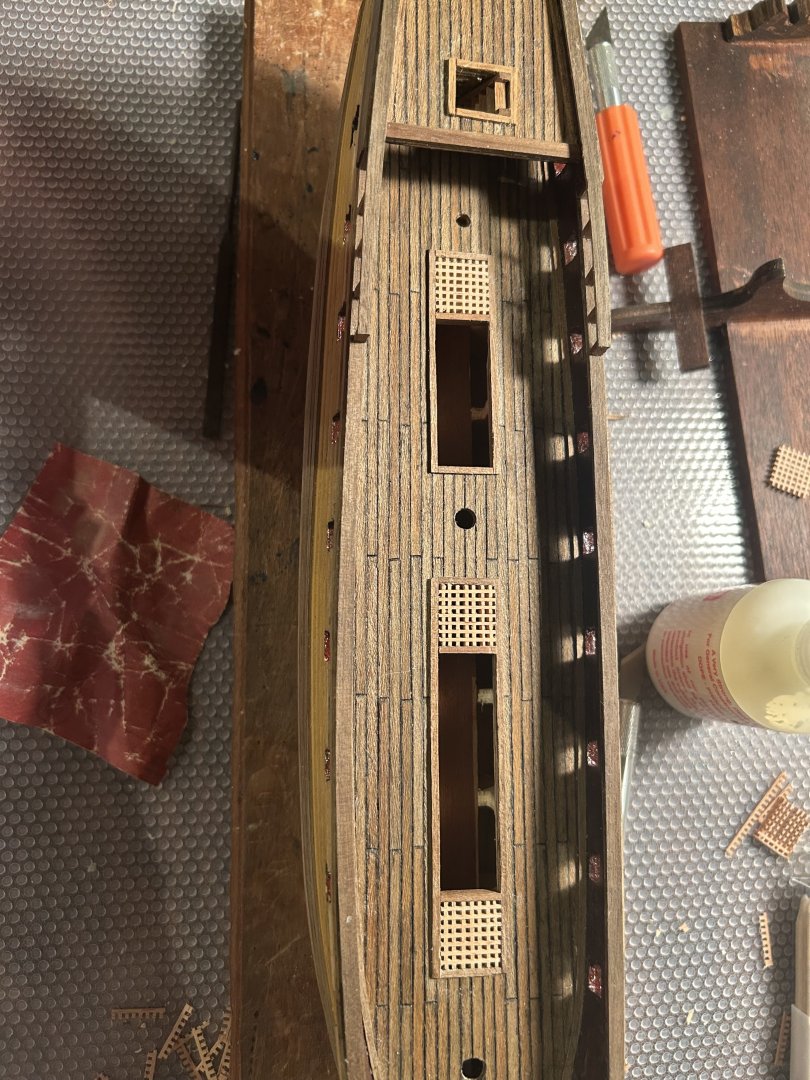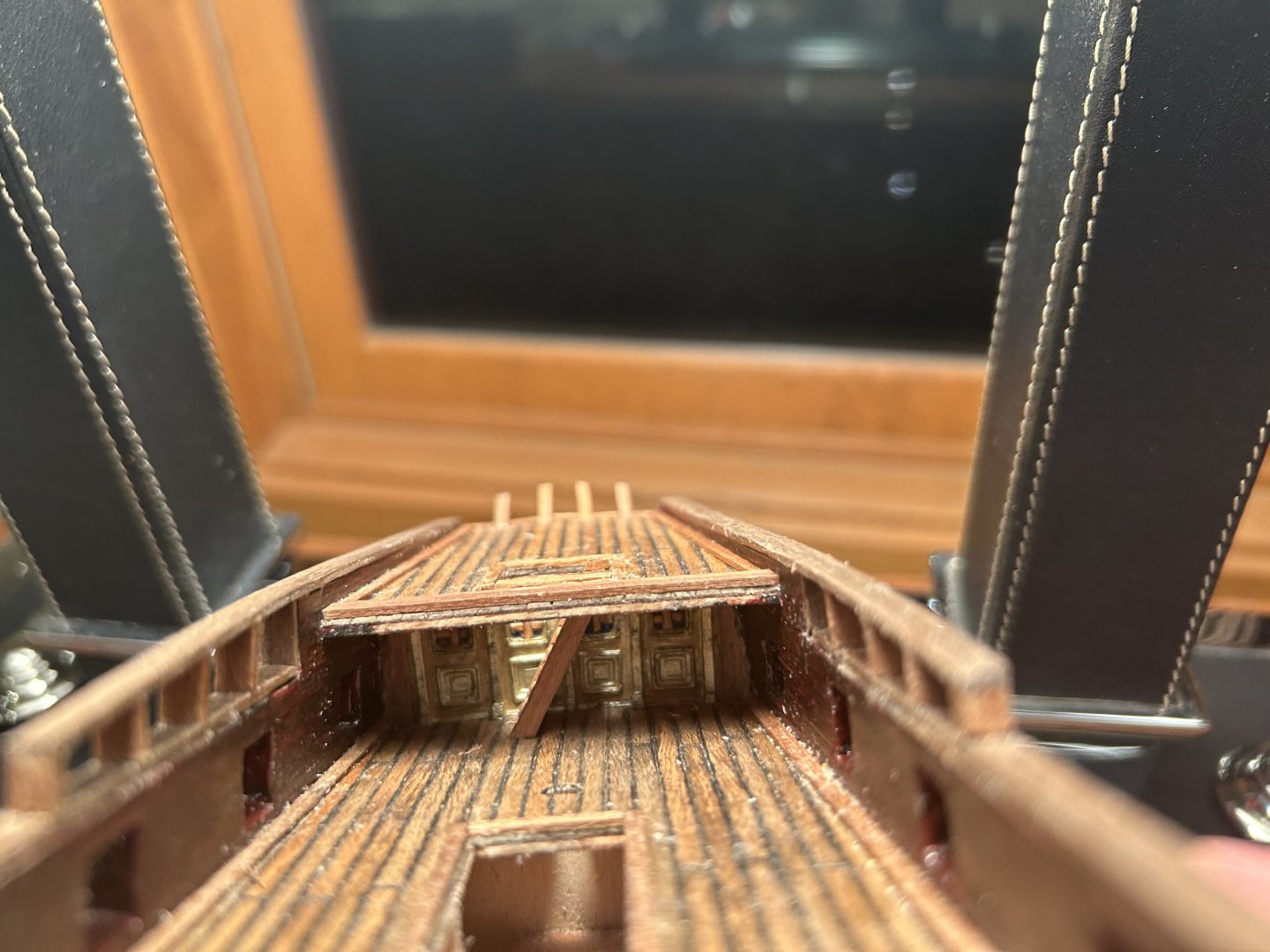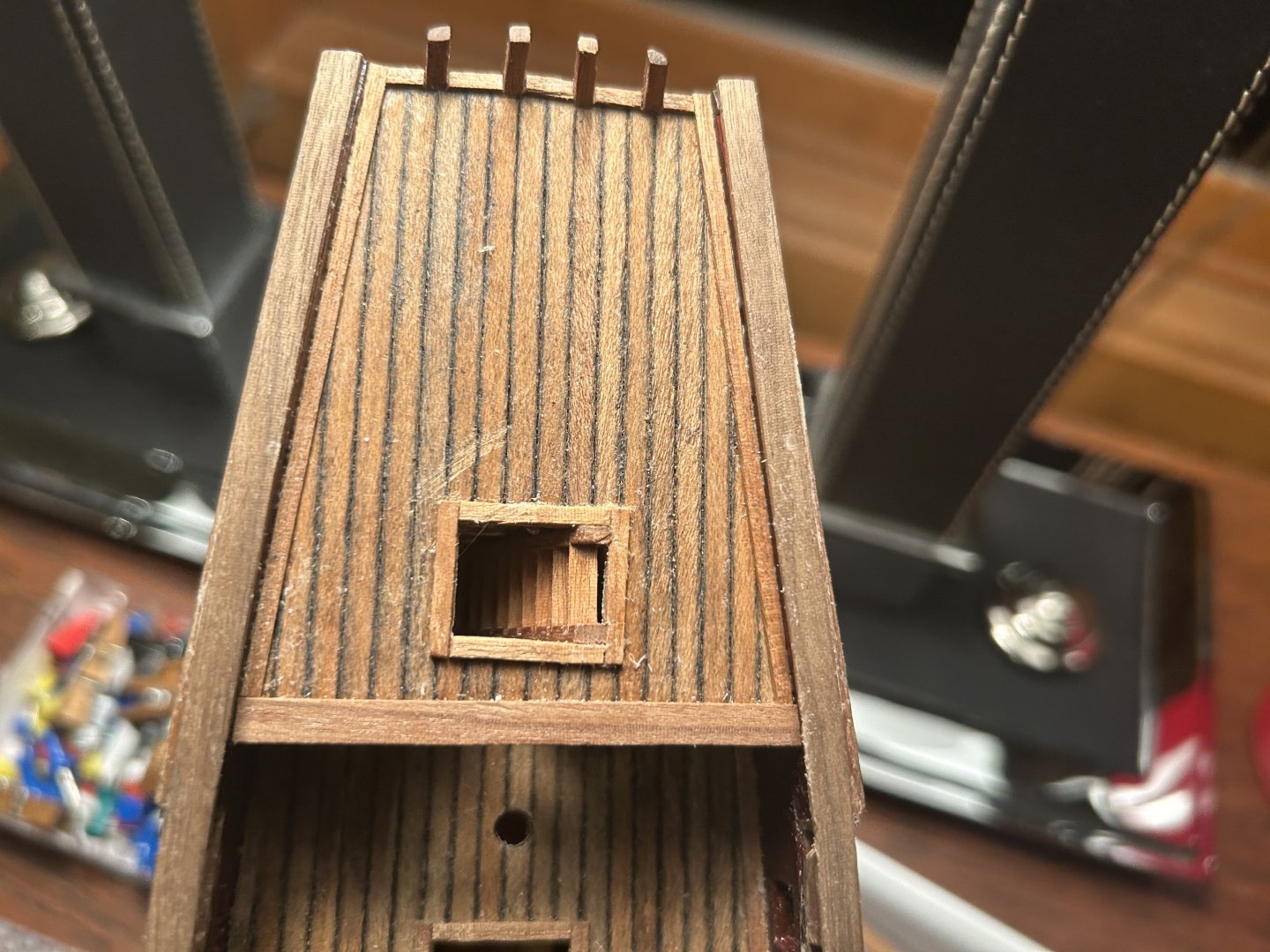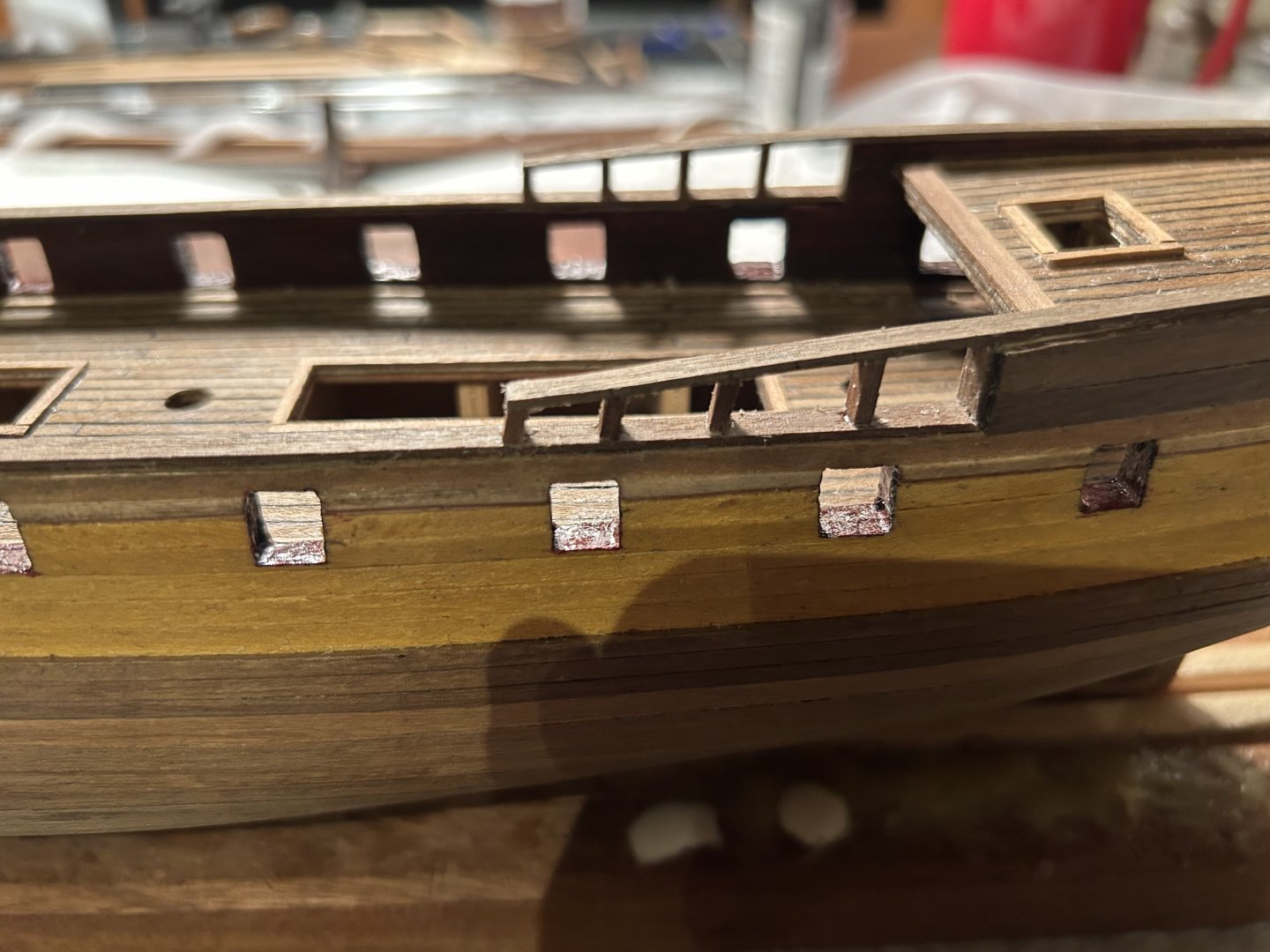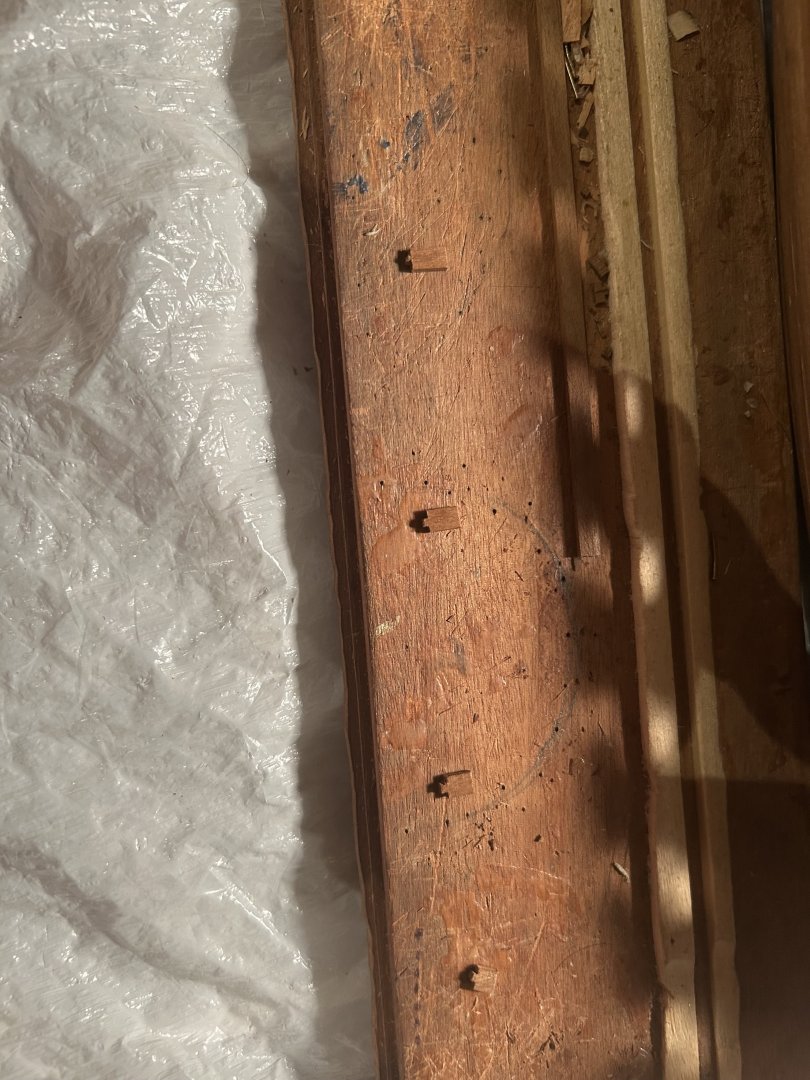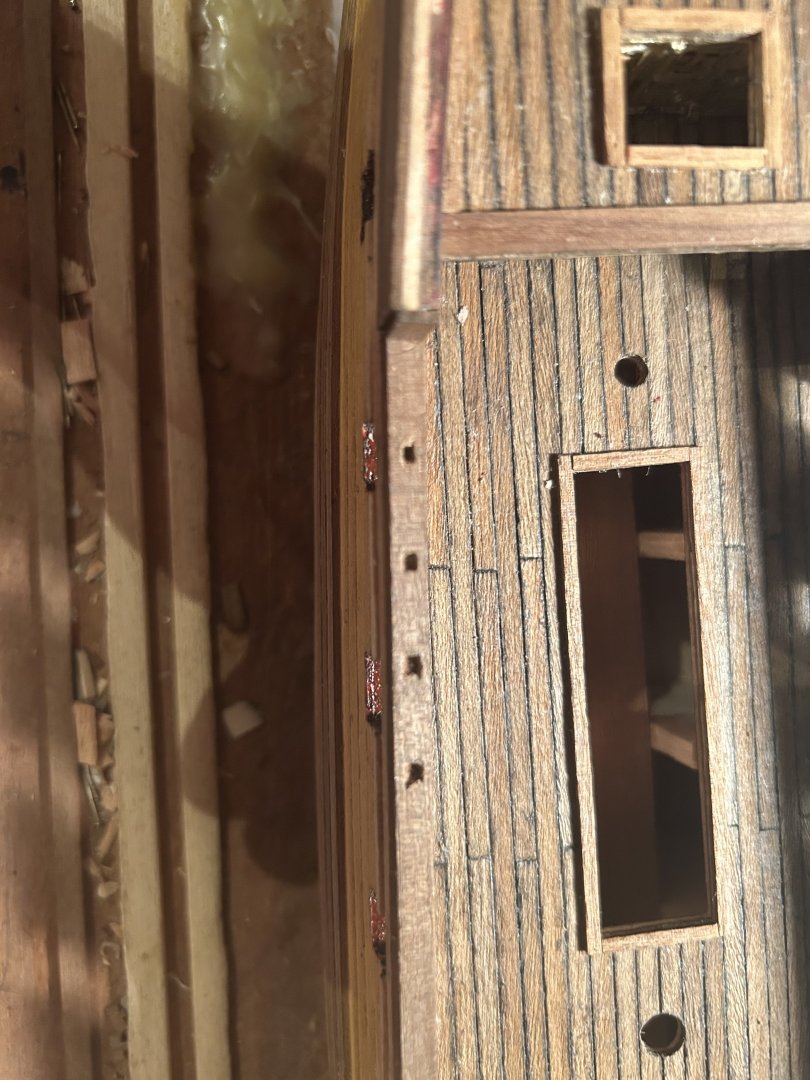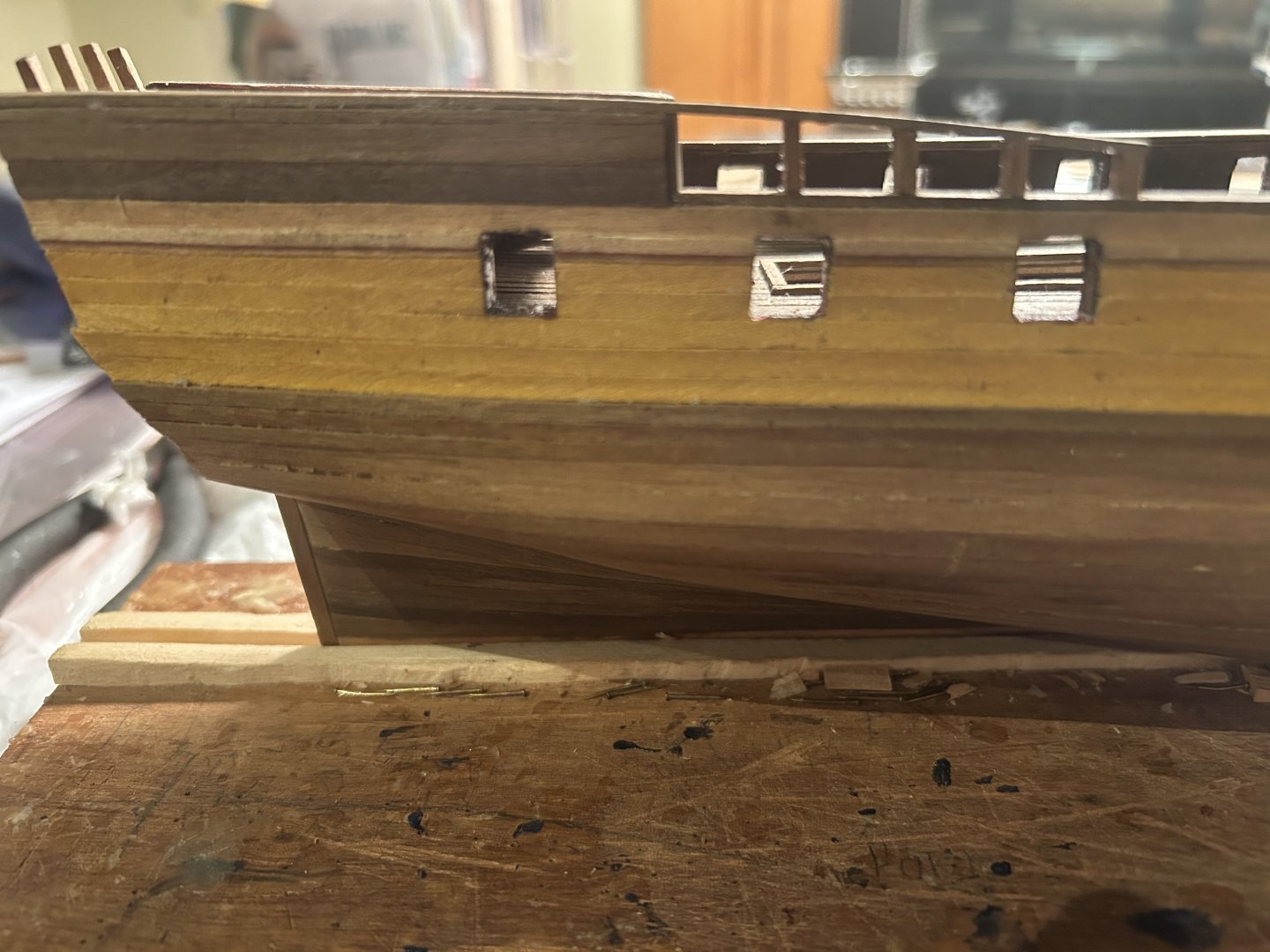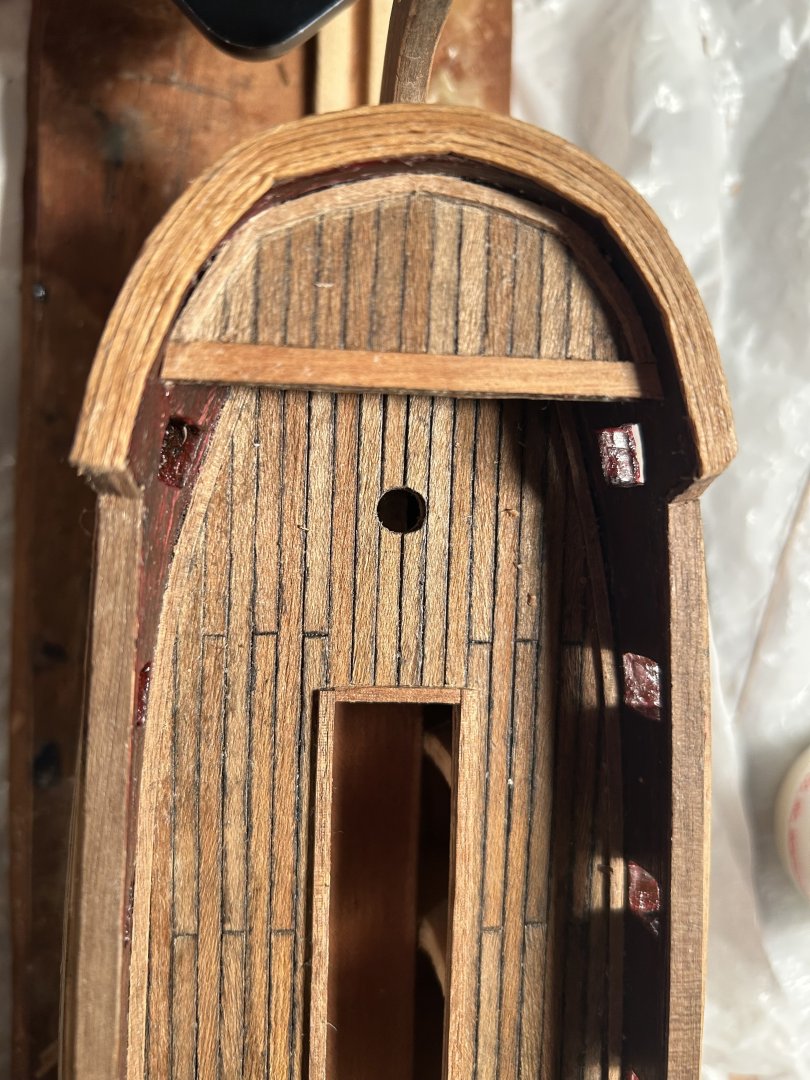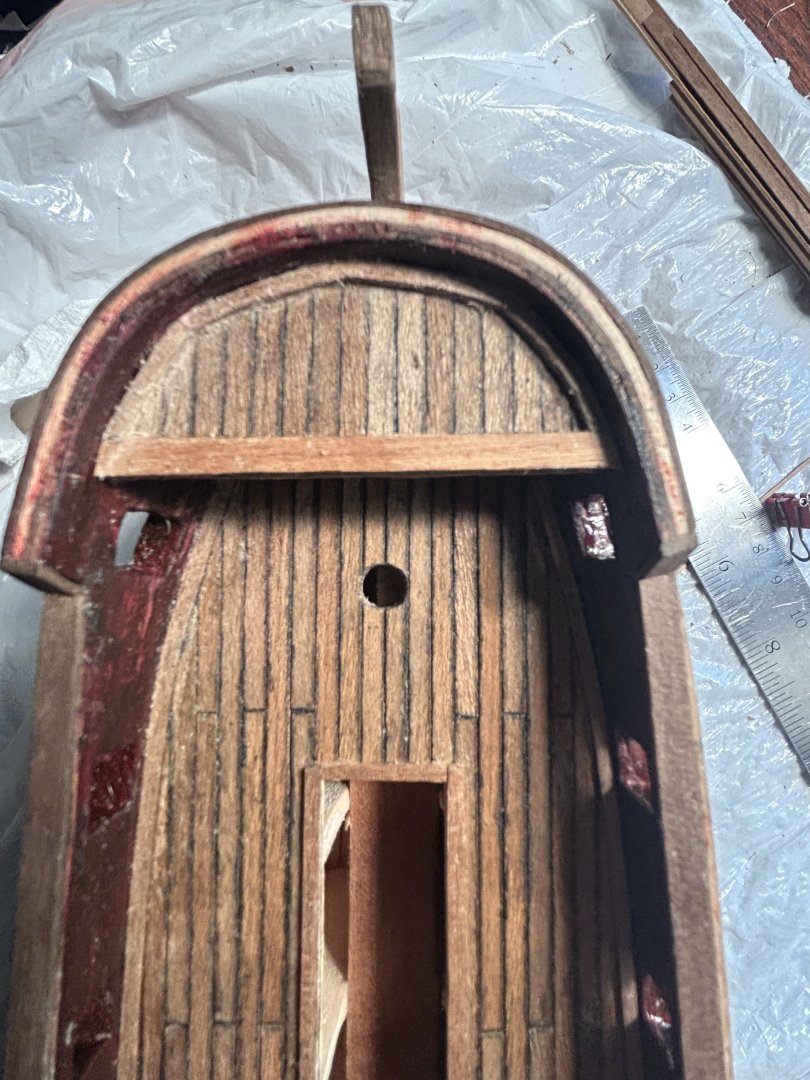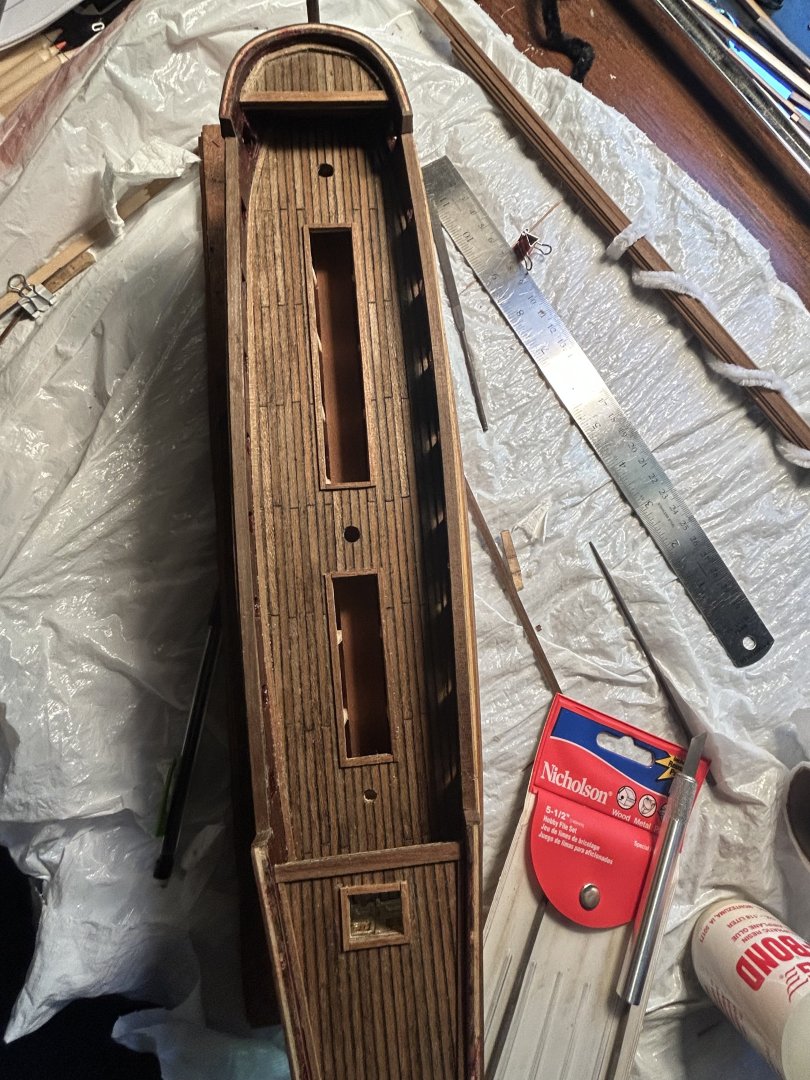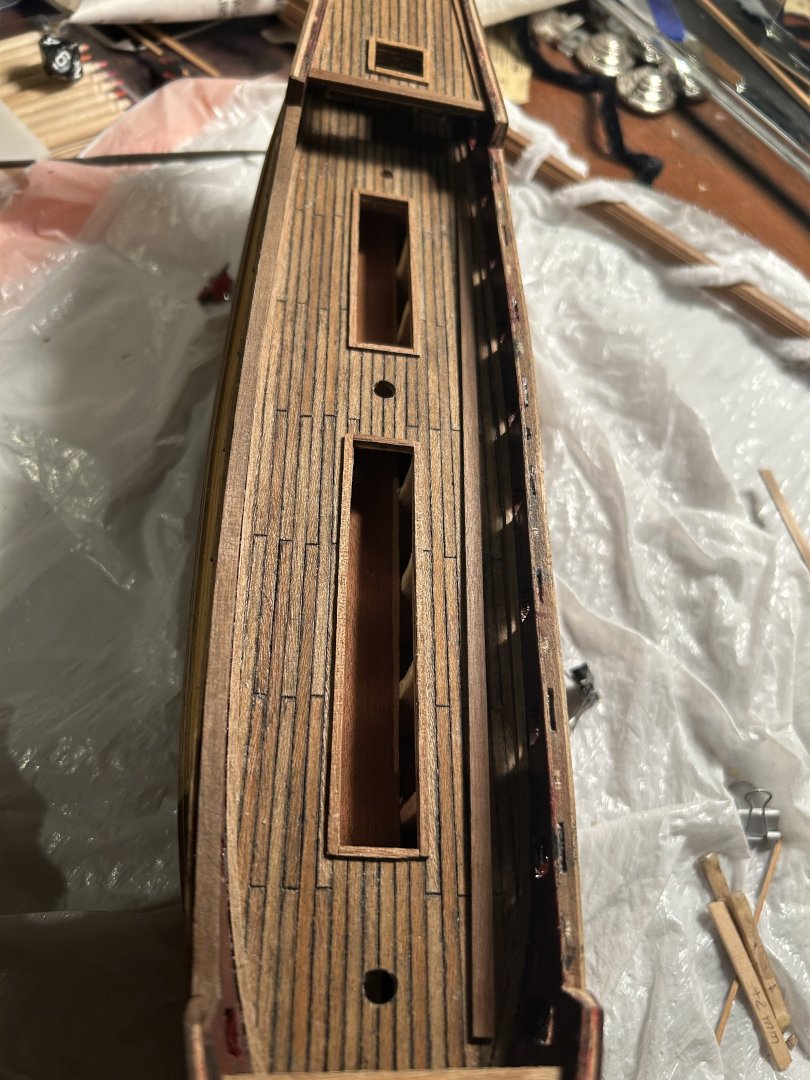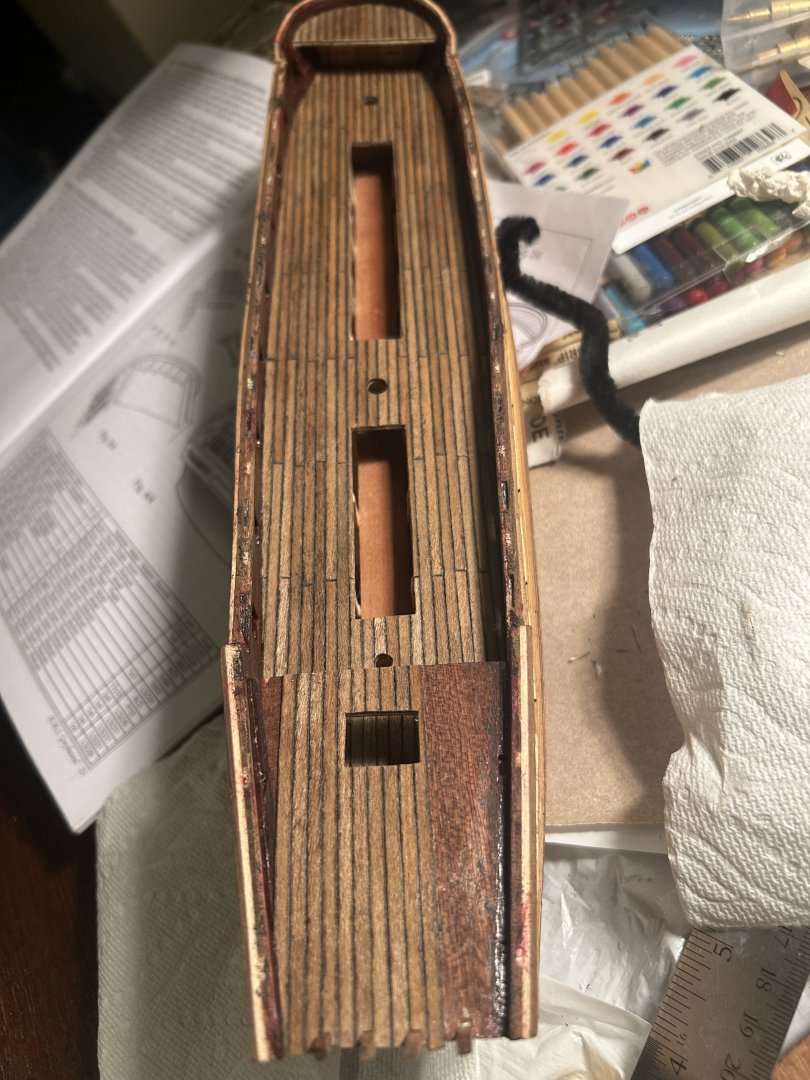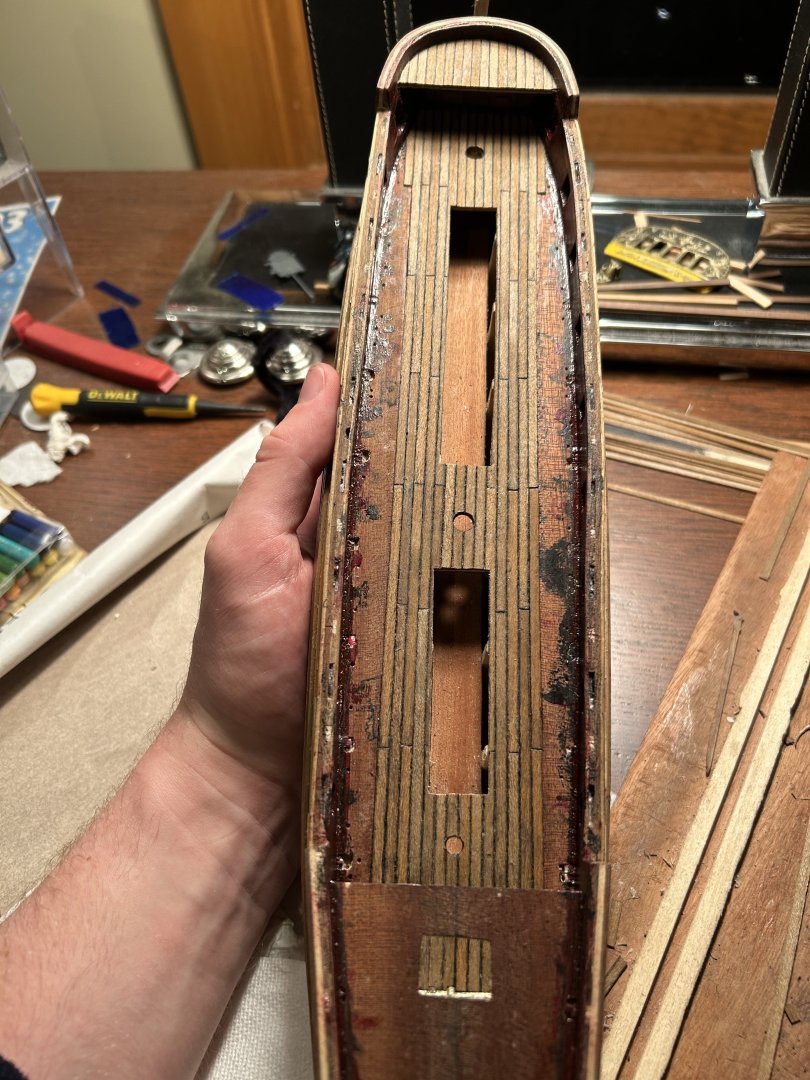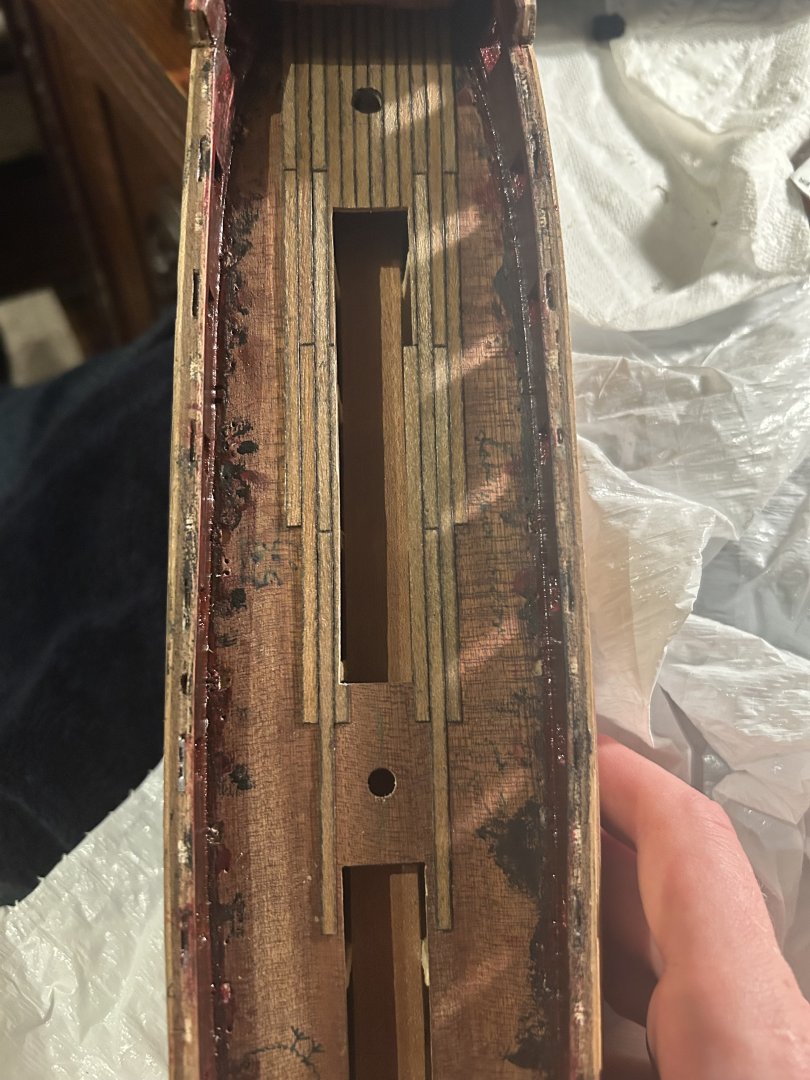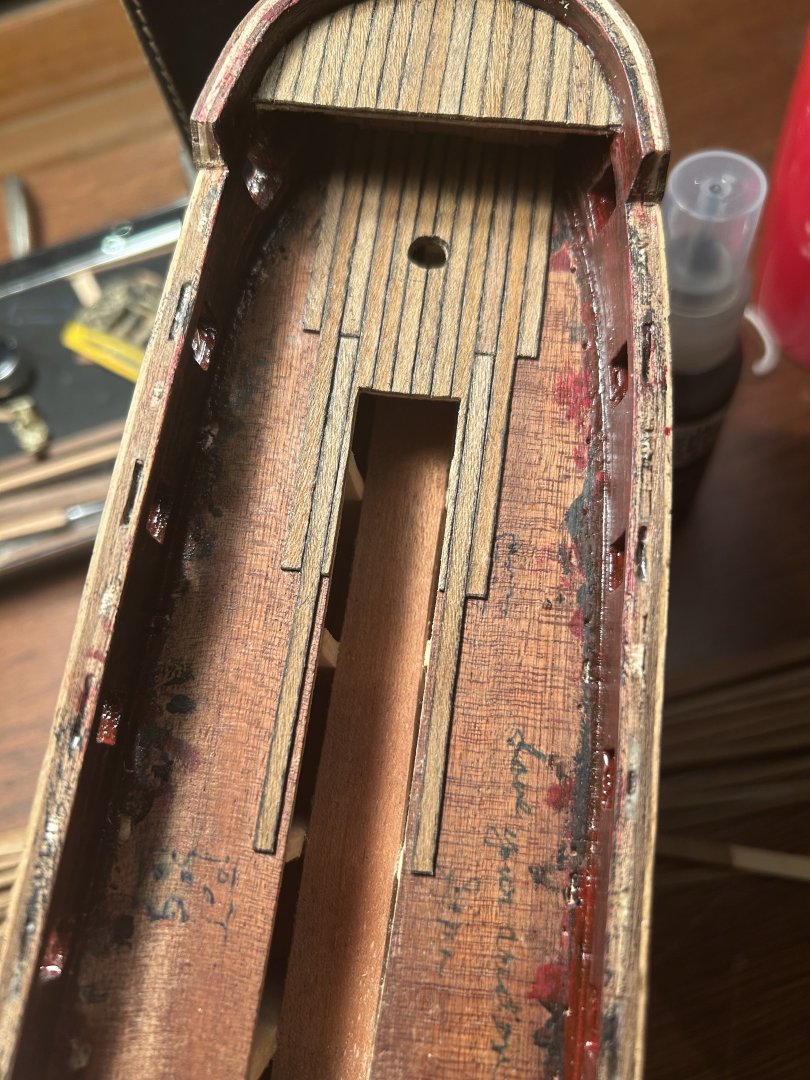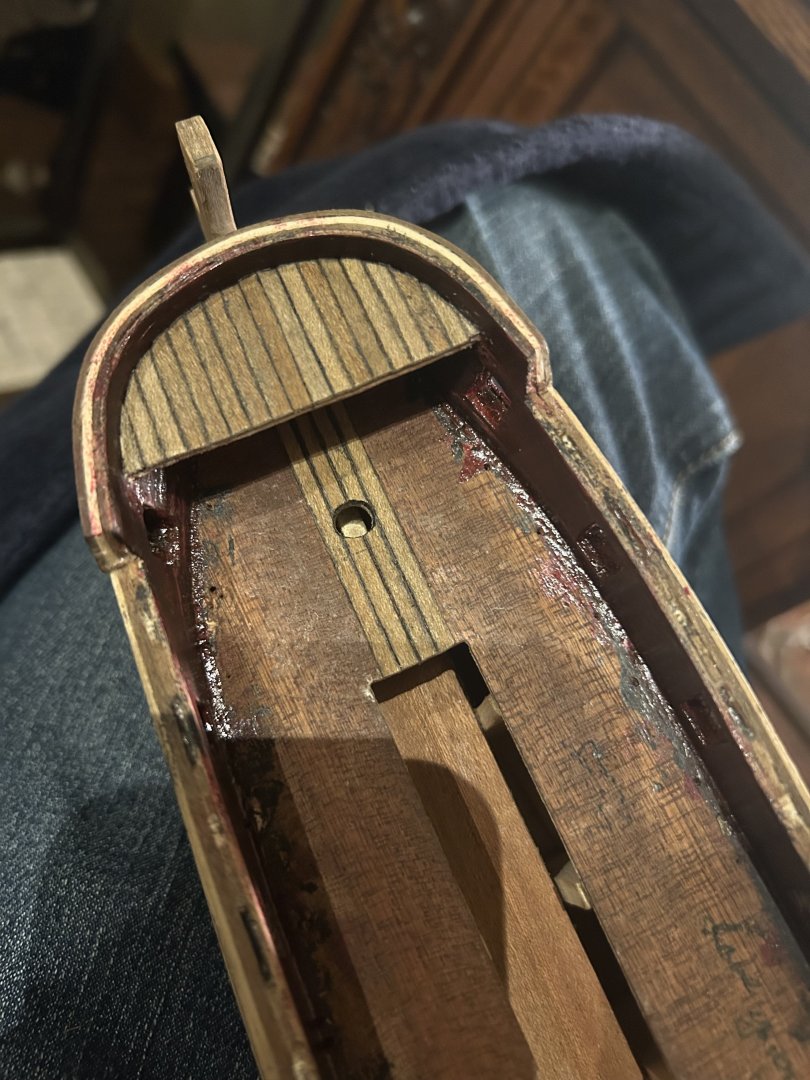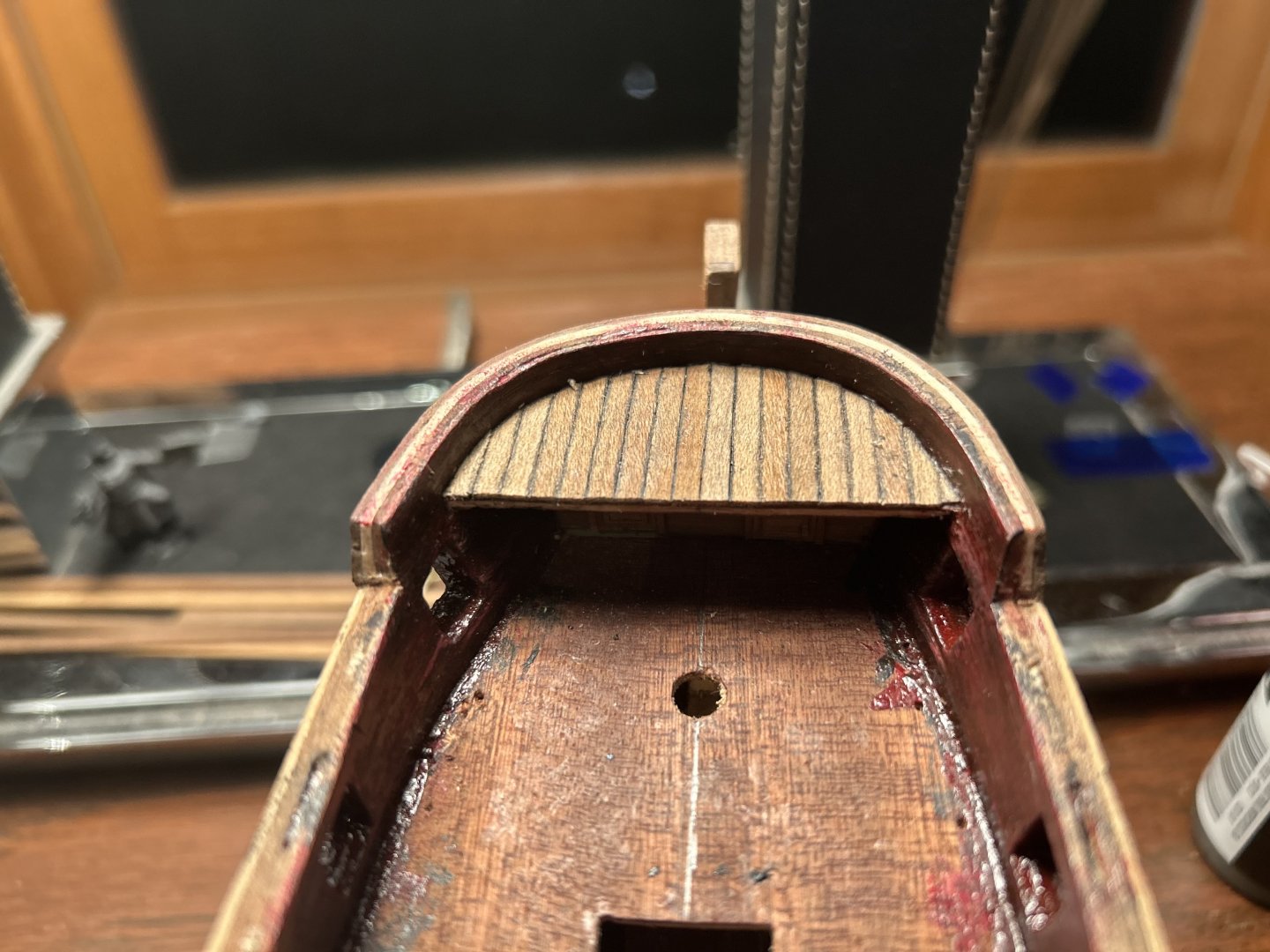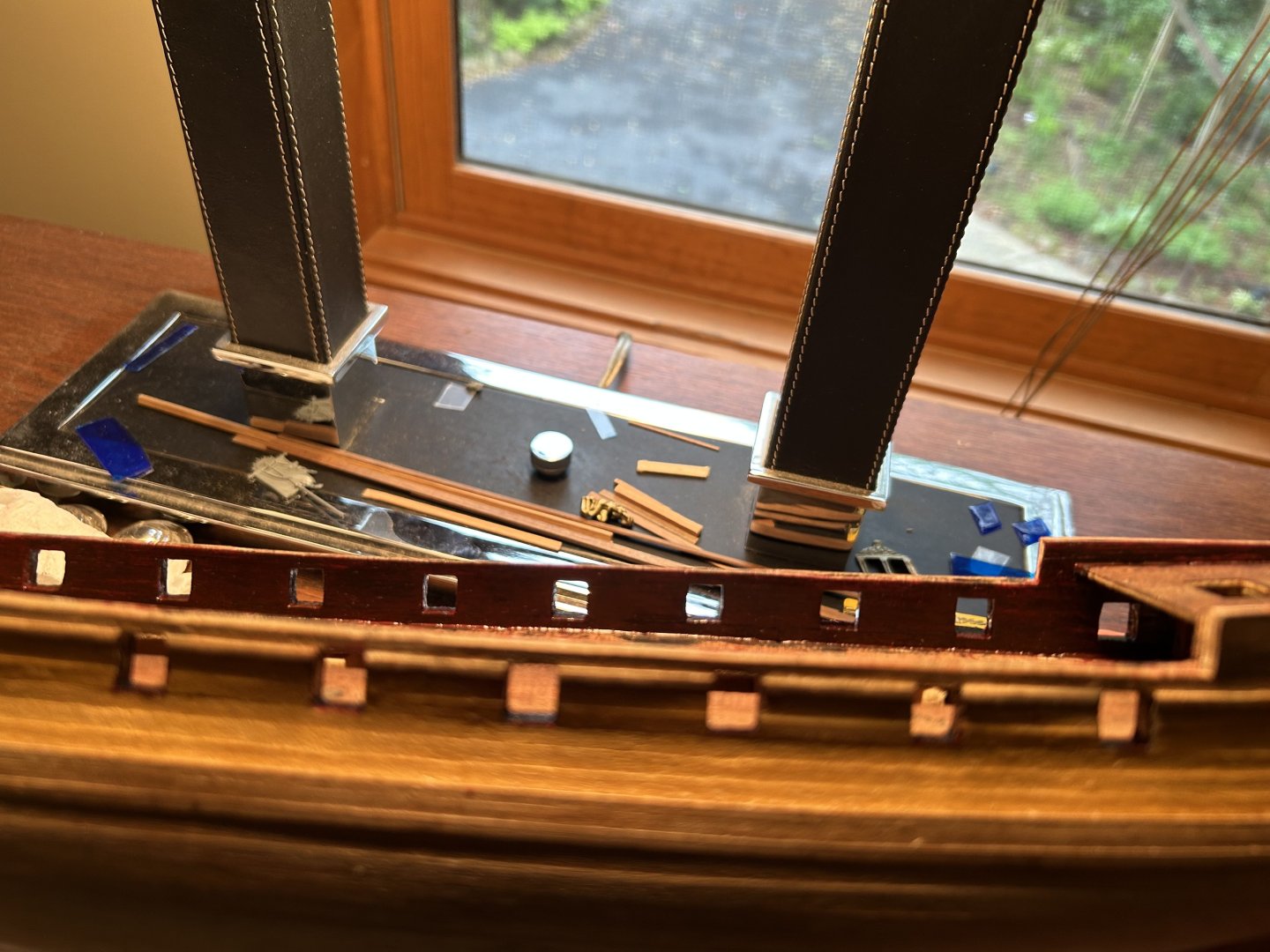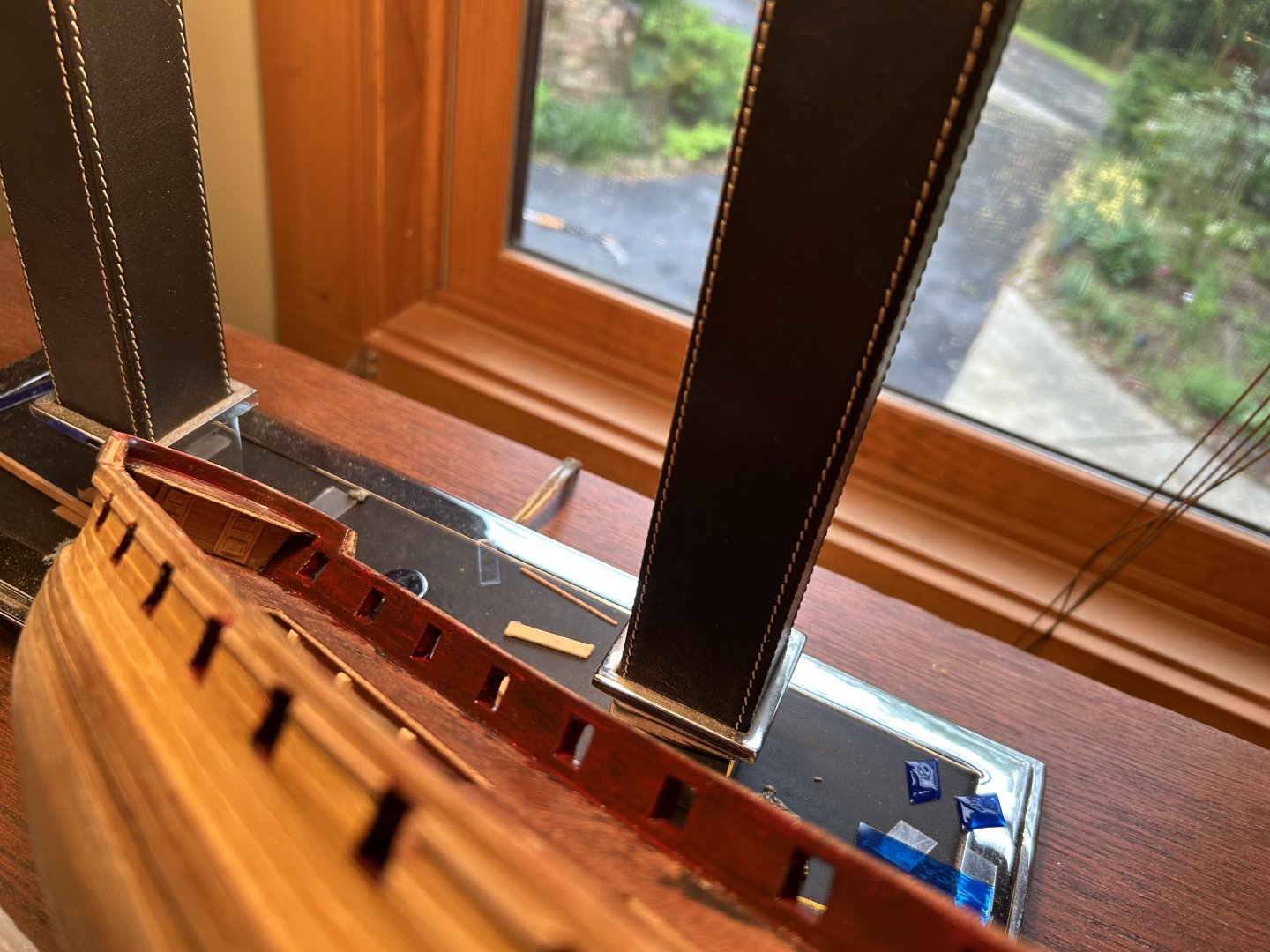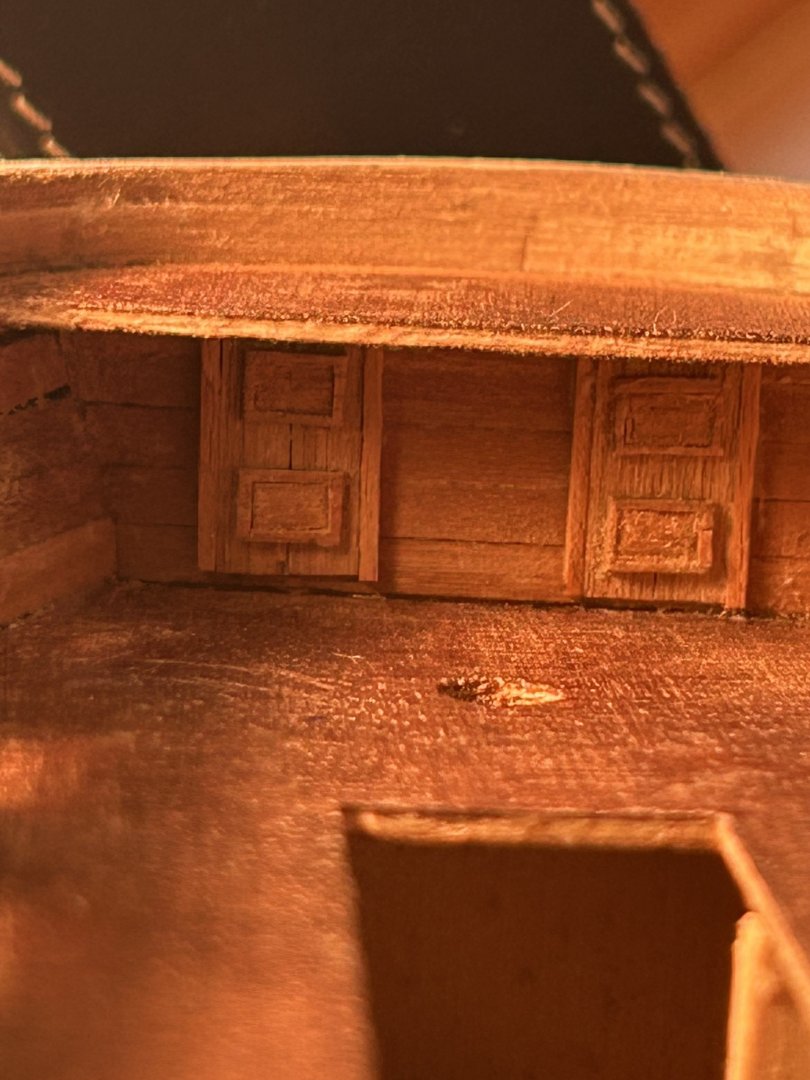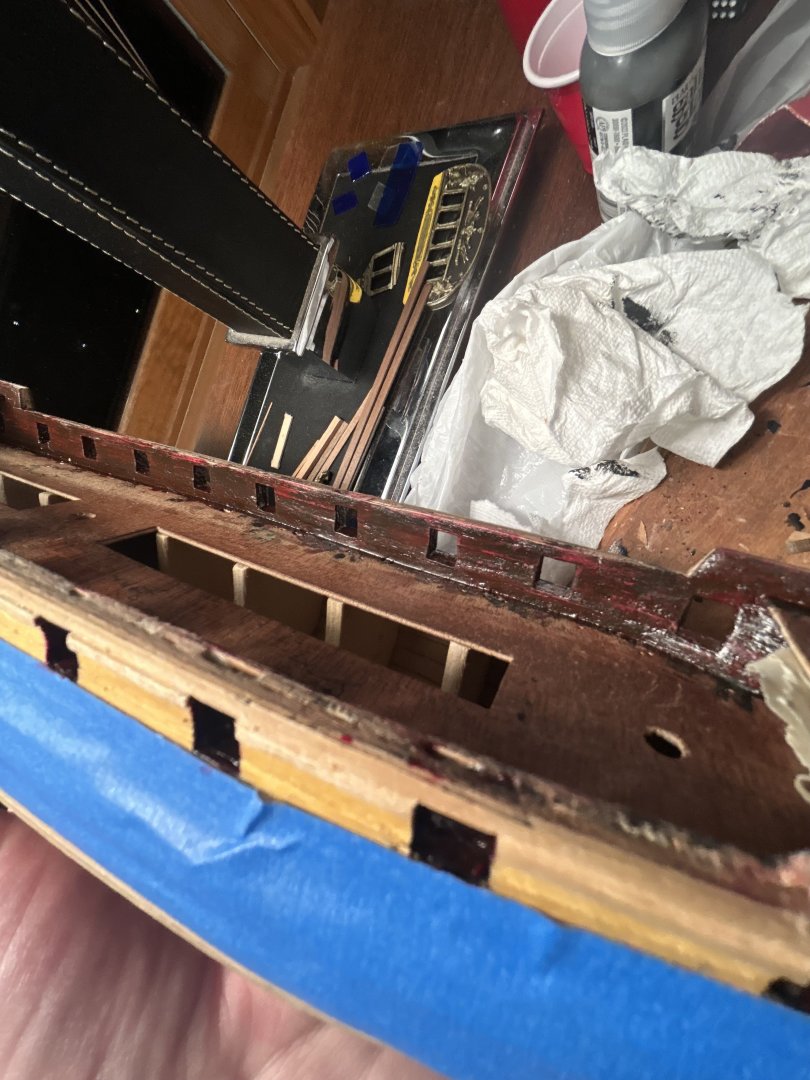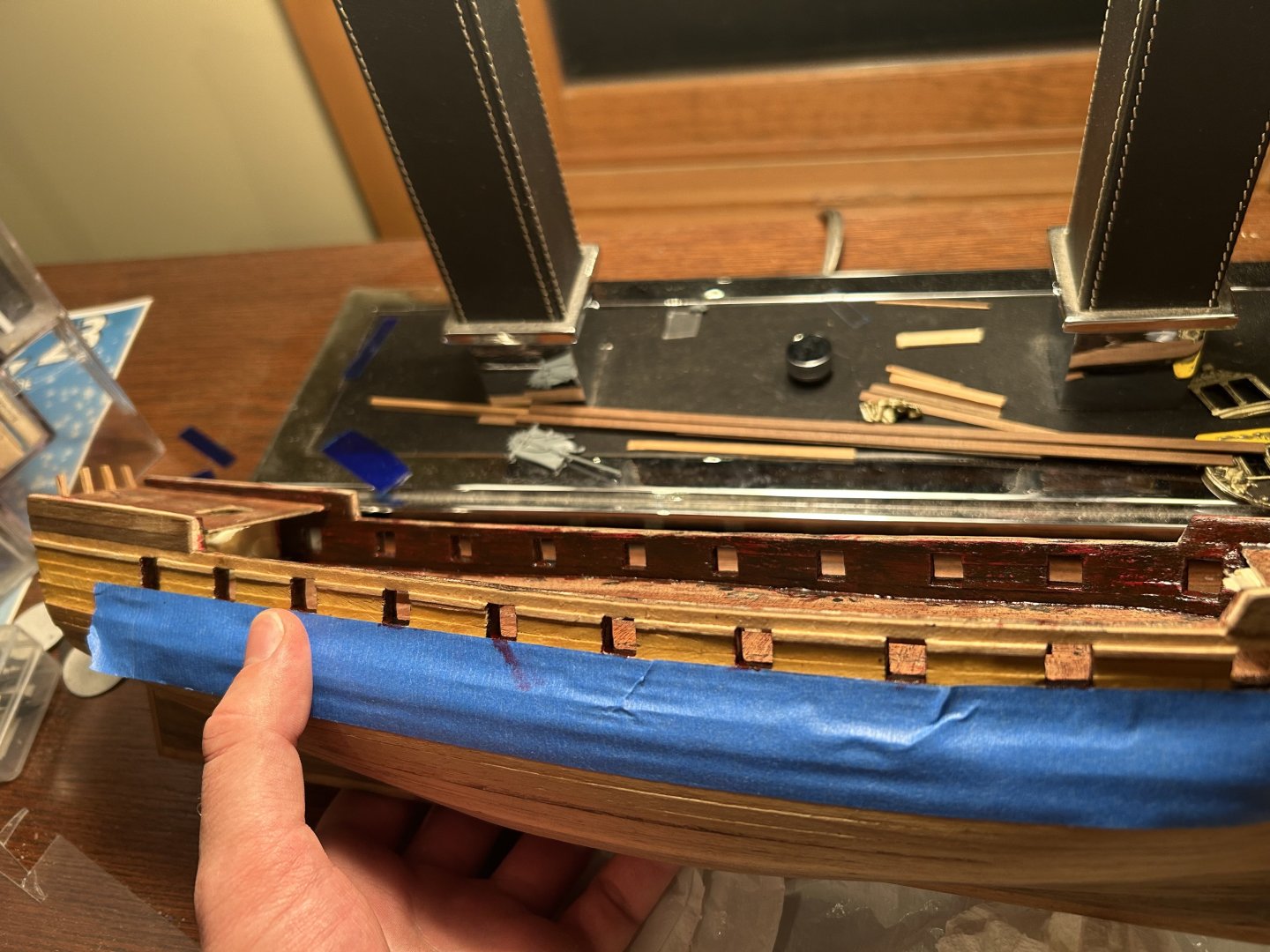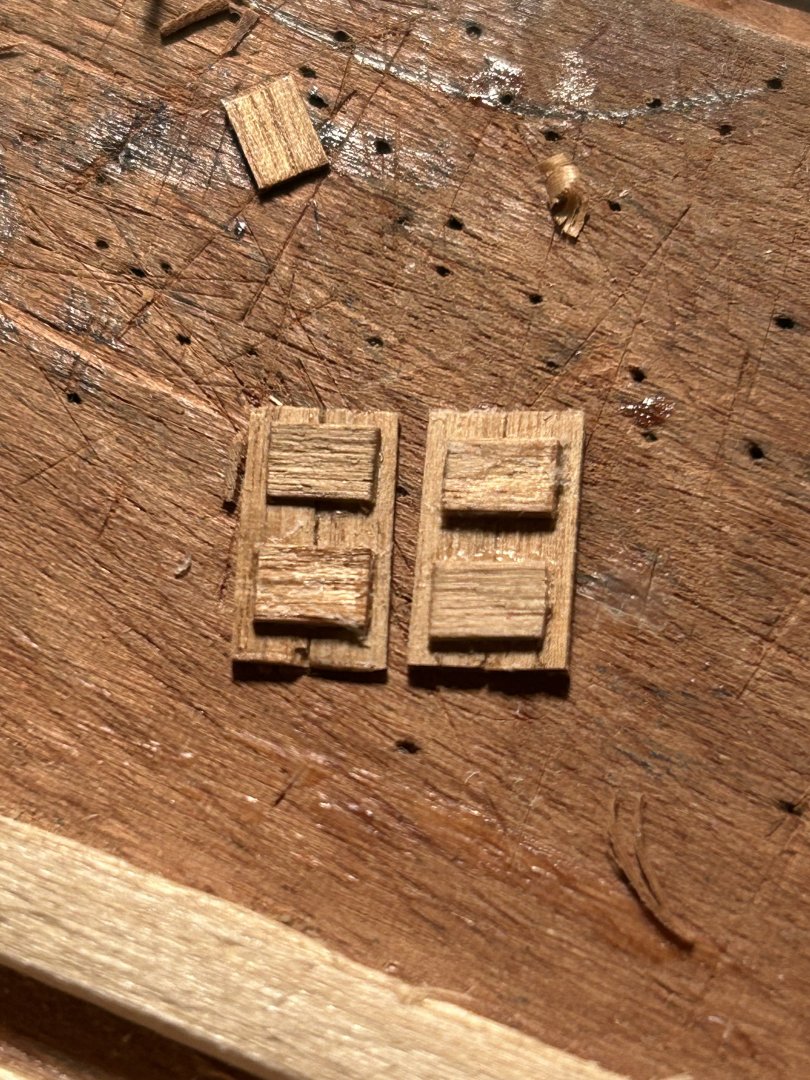
Jackson7
Members-
Posts
179 -
Joined
-
Last visited
Content Type
Profiles
Forums
Gallery
Events
Everything posted by Jackson7
-
This step is fairly self-explanatory. I put the ladders, final gratings, and planks around the gratings on. It's probably pretty obvious that as much as possible, I put the ladders in first. Then I cut them to be relatively flush to the deck. This step was difficult, and I had to make a correction with glue at one point. But overall, it went well. Finally, I put on the gratings. When I was done, I sanded the gratings, planks, and ladders until they were level with each other. Here's a picture. With this step, I've come to a point where I must decide: build my own stern out of wood pieces, or use the kit? Predictably, I've decided on building my own. But I won't make a final commitment until I know the 3D pieces my friend is printing for me work and look good. Of course, that means progress will prove slow and sporadic.
- 209 replies
-
Yesterday, I finished the grates on the stern. As Corel's instructions have no comprehensive and clear pictures on how they should look, I copied from the work of @hamilton and @harlequin. Thanks guys, your pics of the Greyhound have been extremely useful to me. I couldn't have done it without y'all.
- 209 replies
-
These last few steps have been so finnicky and small that they have hardly felt worth photographing. For the stair to the poop deck, I measured and cut a set of stairs, glued the ladder together seperately, then glued it in. I've left some stairs measured to its length over so that all the ladders can be the same consistent size. For the gratings, I glued and assembled them, then sanded them with 800 grain sandpaper until they were smooth. So far, I've attached three. I've been framing them with leftover 2x4mm wood. I have a lot of it. Each time, I sand the gratings on the left and right sides with about 20 strokes, then check if they fit. By "fit," I mean "can be just barely jammed in without making me afraid they will break." If not, I repeat the process. I've decided to kitbash a stern with the help of a good friend of mine who owns a 3D printer. But I'll only take action on that once he visits me with his completed prints. I need to see that it works before committing to a course of action.
- 209 replies
-
At last! The final plank has been bent onto the ship! It's far from perfect, but like most parts of the Greyhound, it's good enough to look mostly right from a distance. After the glue has a chance to dry a little overnight, it should be all good. Here's the result. In the background, you can see I have glued together and stained my stand.
- 209 replies
-
Putting on the port railing was a doozy. I'm not sure how much that was because I'm making it hard for myself versus the nature of the work. Here's the process. First, I put the 1x4mm walnut piece in boiling water for about two hours. I then bent it sideways to the shape of the edge overnight. After that, I cut the railing supports. Rather than just gluing them to the side and the railings, I cut the bottom of them into wood joints that inserted into corresponding holes I carved into the rail. I put each of them 12 mm apart, after I figured out that was about how much rail I had. The final part of the process was cutting them top a smooth height on top so the railing could naturally curve downward. I had to measure and recut many times on each one. The trick was to only slice a tiny bit off at once. The result wasn't quite what I expected, but there's solid contact between each post, the bottom rail, and the top rail. If anyone else wants to take this approach, I advise them to measure everything multiple times. If the starboard side goes just as well, I will be very pleased.
- 209 replies
-
This step went on less horribly than I first imagined. The bow railing of the Greyhound consists of five 1mm strips, all bent to shape and glued side by side to form what will appear to be one plank. 1mm wood bends sideways much easier than 4mm wood, thankfully. I used the same jig I used for the rest of the hull and bent all five pieces to shape at once. After a good 2 hours of boiling, a bend on the jig, and 24 hours to learn its new shape, the wood went on perfectly. After the glue has several hours and I sand the wood a little for smoothness, it should make a nice, clean railing.
- 209 replies
-
Welcome! I'm in North Georgia as well and working on an HMS Greyhound with awful instructions too. I'd be glad to talk with you sometime!
-
I got on the last main deck railing, as well as the bulwark lining. A word to all those doing something like this in the future: It's good to make sure the surface you're gluing the railing to is absolutely flat before making a start of it. I had to cut it smooth at the last minute. The lining went on well, but bending a piece of wood against the grain like that just doesn't work well. I certainly won't use the same method on the final bow railing.
- 209 replies
-
Thanks for posting this! I'm building the Greyhound, and given the dubious instructions this will prove inestimably helpful!
-
The deck framings are all done, except for the one on the bow, which I will have to shape out of scrap wood. While I'm on a bending long pieces spree, I put on the starboard railing. The trick to cutting a straight piece of wood to an irregularly curved surface was actually fairly simple. First, I measured the distance by bending some scrap wood into the same general area. Then, I cut the finishing plank to length by taking a tiny bit off at a time, then seeing if it fit. If you are very cautious, this method can get you a near-perfect fit. I held it in place while the glue dried by hand and with a set of clips. It worked in the end. I'm very thankful for podcasts and movies that can keep my mind occupied while trying to hold finnicky pieces in place. I don't know what I would do without them...
- 209 replies
-
I've saved these last pics for a bit, just because the next few steps have been so simple. These are all the framings for the deck, and they've been going on fairly easily. I have one more long piece to cover the port gunwale line, and one more to cover the gunwale line on the quarterdeck. The one big complication was that Corel didn't give me enough wood, and I had to cut scrap wood to shape on some of the pieces. Bonus points to you if you can guess which.
- 209 replies
-
Done with the deck planking. Now, I just need to do the structural details on the deck. If there was one lesson I learned from this step, it was to measure the deck and draw a line down its center before attaching it to the ship. It would have been far easier to get a clean center line that way. As it is though, I'm only 1 mm off at worst.
- 209 replies
-
The main deck is now finished, and I've started on the poop deck. In fact, I'm slightly ahead of the pictures at present. This is probably one of the more monotomous parts of the process, but nevertheless has a degree of satisfaction. Soon there won't be a scrap of plywood showing on the model.
- 209 replies
-
I have roughly 6 mm on either side left to go. Of course, cutting the planks to a nice irregular curve will be a challenge. Otherwise though, things have mostly gone well.
- 209 replies
-
Despite the fact that I no longer have to go to the lengths of boiling and bending planks, I still find my max pace per day is about two uncut planks worth of wood. It looks like things are going in the right direction, however. I have finished the center, and it is maybe 1 mm off toward the stern. But I don't think it's a big deal because it's not that visible.
- 209 replies
-
The advance slowly continues. As of now, the plan is to plank along the middle, then build outward from the sides and deal with all the fiddly bits that have to fit the ship's curves last. By doing it this way, I should leave myself a solid base to build out from. Of course, given that the ship supplies pieces that frame the deck against the sides, I most likely don't need to be too worried about getting the space between the two absolutely perfect. With luck, I should be able to plank all the way to the cabin doors in three or four days. After that, I think I'll build to the sides of the main deck.
- 209 replies
-
Good news! I've put planks over the entire beginning of the ship, and it's perfectly centered for certain. Now I just need to countinue going down toward the stern.
- 209 replies
-
After careful measurement, I've started blanking the main deck. I've done my best to get the first four planks straight as possible. I think I've succeeded as best as I can for doing things by hand. These first four are important because they will serve as the cornerstone by which I will measure the rest of the ship.
- 209 replies
-
After a few interruptions for important events, I'm back to work. Tonight I finished the foredeck. The lines between the boards comes from a colored pencil. The whole process with these deck planks is extremely straightforward. Although I can see now that the planks must've been slightly off center.
- 209 replies
-
Today I've dyed the deck boards. All I had to do was soak steel wool in vinegar for two days, then brush the mixture onto the boards. After I use a colored pencil on the sides, they should be ready to go onto the deck.
- 209 replies
-
Just finished the second coat of red paint. I like how it looks a little weathered, and I don't think a third will do that much good. Once it dries, I'll get working on the deck.
- 209 replies
-
Much has transpired since the last update. I glued on the doors for the bow, primed the inner gunwales black, and painted them red. After it dries, I'll make the decision on whether it needs a second coat or if a more worn look is best.
- 209 replies
-
Seeing that the next step before putting on the rail is painting the gun ports red, I need to buy brushes. In the meantime, I realized a pair of doors for the forecastle would look nice. Here's what I've made. And done. Just a little carving and they become a lot better.
- 209 replies
-
Judging from the posts of some others on the forum, it's better to finish all my gluing first before putting on wood oil. That said, I'll now keep going on the rest of the ship.
- 209 replies
About us
Modelshipworld - Advancing Ship Modeling through Research
SSL Secured
Your security is important for us so this Website is SSL-Secured
NRG Mailing Address
Nautical Research Guild
237 South Lincoln Street
Westmont IL, 60559-1917
Model Ship World ® and the MSW logo are Registered Trademarks, and belong to the Nautical Research Guild (United States Patent and Trademark Office: No. 6,929,264 & No. 6,929,274, registered Dec. 20, 2022)
Helpful Links
About the NRG
If you enjoy building ship models that are historically accurate as well as beautiful, then The Nautical Research Guild (NRG) is just right for you.
The Guild is a non-profit educational organization whose mission is to “Advance Ship Modeling Through Research”. We provide support to our members in their efforts to raise the quality of their model ships.
The Nautical Research Guild has published our world-renowned quarterly magazine, The Nautical Research Journal, since 1955. The pages of the Journal are full of articles by accomplished ship modelers who show you how they create those exquisite details on their models, and by maritime historians who show you the correct details to build. The Journal is available in both print and digital editions. Go to the NRG web site (www.thenrg.org) to download a complimentary digital copy of the Journal. The NRG also publishes plan sets, books and compilations of back issues of the Journal and the former Ships in Scale and Model Ship Builder magazines.

